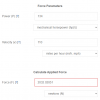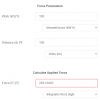Use this calculator to determine the velocity of a moving object in mile per hour, kilometre per hour, knot, metres per second or feet per second units, with a defined power output and force applied v=P/F
Movement & Motion Calculators
Online web tools for converting and calculating parameters associated with the movement and motion of physical objects.
Power & Velocity to Force Calculator
Use this calculator to determine the force in newton, pound-force, kilogram-force or kilonewton units, applied to a moving object with a specific power output and velocity F=P/v
Force & Velocity to Power Calculator
Use this calculator to determine the power in watt, kilowatt or horsepower units, produced by a moving object with a specified applied force and velocity P=Fv
Work Done & Applied Force to Distance Moved Calculator
Use this calculator to determine the distance an object is moved by using the amount of energy transferred or work done and the force applied to the object d=W/F
Work Done & Distance Moved to Applied Force Calculator
Use this calculator to determine the force applied to an object to use a specified amount of energy or do work to move an object over a defined distance F=W/d
Force Applied & Distance Moved to Work Done Calculator
Use this calculator to determine the work done to move an object with a specific amount of applied force over a defined distance W=Fd
Work Done & Power Output to Time Taken Calculator
Use this calculator to determine the elapsed time from the total energy transferred or work done and the power output t=W/P
Power & Elapsed Time to Work Done Calculator
Use this calculator to determine the work done from the power output and the time taken W=Pt
Work Done & Elapsed Time to Power Calculator
Use this calculator to determine the power from the total energy transferred or work done for a given period of time P=W/t
Kinetic Energy & Mass to Velocity Calculator
Use this calculator to determine the velocity of a moving object from the kinetic energy or work required to accelerate or decelerate an object, and its mass v=√(2KE/m)
Kinetic Energy & Velocity to Mass Calculator
Use this calculator to determine the mass of an object from the kinetic energy or work required to accelerate or decelerate an object, and its velocity m=2KE/v²
Mass & Velocity to Kinetic Energy Calculator
Use this calculator to determine the kinetic energy of moving object, or the work necessary to accelerate an object from rest, or decelerate a moving object to rest, with a specified mass and velocity KE=½mv²
Force & Mass to Acceleration Calculator
Use this calculator to determine the acceleration from the net force applied to or produced by an object and its mass a=F/m
Force & Acceleration to Mass Calculator
Use this calculator to determine the mass from the net force applied to or produced by an object and its resulting acceleration m=F/a
Mass & Acceleration to Force Calculator
Use this calculator to determine the force for an object with a given mass and acceleration F=ma
Speed Converter
This speed converter tool will convert a distance travelled in a unit period of time to different units and show a related speed conversion scale.
Acceleration Converter
This tool will convert acceleration into different measurement units and show a conversion scale for different rates of speed.

















